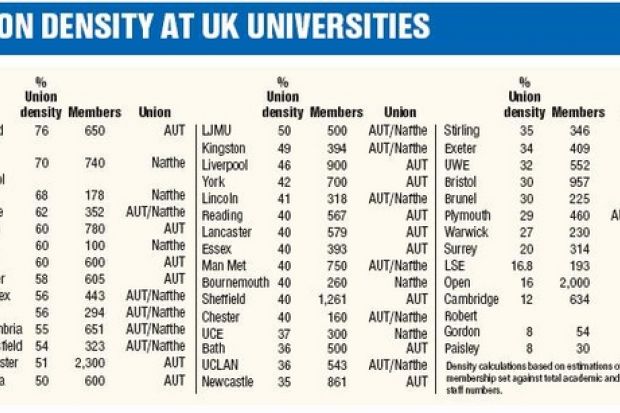As the boycott action takes hold, The Times Higher reports on the prospects of local pay negotiations and maps out Natfhe's and the AUT's strongholds
It isn't a simple matter of numbers when it comes to finding out where the dispute has hit hardest, finds Alan Thomson
When it comes to hotbeds of union activity some universities are simply hotter than others, according to an investigation into membership density by The Times Higher.
Wide variations in the proportion of unionised academics compared with total academic numbers are revealed by the study, which may also indicate how effective the unions' assessment boycott will be in individual institutions.
Both the Association of University Teachers and lecturers' union Natfhe guard membership figures jealously for fear of giving employers more information than is strictly necessary, particularly during a dispute.
But even if the unions did release accurate figures, calculating union density would still be a numbers game as it depends largely on the total number of academic staff against which membership is measured.
To maximise density the unions tend to restrict total staff numbers, for instance to permanent academics alone.
Employers, on the other hand tend to inflate total staff numbers, for instance by including hourly paid staff, to reduce density.
So, in the spirit of openness, The Times Higher has enlisted the help of universities and local union representatives to produce the first ever glimpse of union hot spots across the sector. Figures have been compiled for about a third of universities.
Bradford University emerges as the hottest of union hot spots, with 500 AUT members, which is, according to the university, 76 per cent of its 650 academic staff.
Sheffield Hallam University comes next, boasting 720 Natfhe members which is, according to the university, 70 per cent of its academic staff.
Alan Dainty, head of employee relations at Sheffield Hallam, said: "It's no surprise that Sheffield and its region have a high union membership in most sectors. It's part of the history and tradition of the area.
"The fact that unions represent so many of our staff actually makes consultation and negotiation more meaningful and we consider that we have a very good relationship with them."
Next is Liverpool Hope University, where 68 per cent of the 250 academics are in Natfhe.
Interestingly, the Natfhe branch at Liverpool Hope estimates its membership at 50 per cent of all academic staff, including part time and hourly paid - a full 18 per cent lower than the number estimated by management.
But Sam Pryke, Natfhe officer at Liverpool Hope, said that size was not everything when it came to the assessment boycott. "Even a small percentage of withheld marks can disrupt the smooth processing of marks," he said.
At the other end of the scale Cambridge University reported that the AUT had 634 members, accounting for just 12 per cent of total academic and related staff numbers.
Mike Clark, president of the university's AUT branch, took issue with the institution's estimate. "Even if you accept 634, to reach 12 per cent, they must have included all fixed and short-term contract staff and most of them are not strongly unionised.
"The fact is that as a branch we are punching well above their claimed 12 per cent figure."
The London School of Economics claimed that just under 17 per cent of its 1,148 salaried academic and academic-related staff were members of the AUT, although a spokesperson pointed out that this excluded many of the academics who paid union subs by direct debit and not through the payroll.
Chris Husbands, president of the local AUT branch, said: "The figure is nonsense. I don't know exactly how many members we have at the moment, but it is well over 300. You are talking about a density in the high 30s."
The Times Higher investigation also seemed to confirm the suspicion across higher education that sociologists and - to a lesser extent arts and humanities academics - are more heavily unionised than scientists.
Sociology was reported as a hotbed of unionism by Lancaster, West of England, Bristol, Lincoln, Stirling, Liverpool Hope and Liverpool universities.
But there were some surprises including Bristol University, which reported a high concentration of union members in its clinical sciences department; Manchester Metropolitan, where the Business School was a hive of union activity; and Kingston University, where the engineers have built a strong union presence.
Nationally, the AUT said that at least 70 per cent of permanent lecturers in pre-92 universities are members.
Natfhe puts the same figure on its membership among permanent staff in the post-92 institutions.
alan.thomson@thes.co.uk </a>
Register to continue
Why register?
- Registration is free and only takes a moment
- Once registered, you can read 3 articles a month
- Sign up for our newsletter
Subscribe
Or subscribe for unlimited access to:
- Unlimited access to news, views, insights & reviews
- Digital editions
- Digital access to THE’s university and college rankings analysis
Already registered or a current subscriber?
